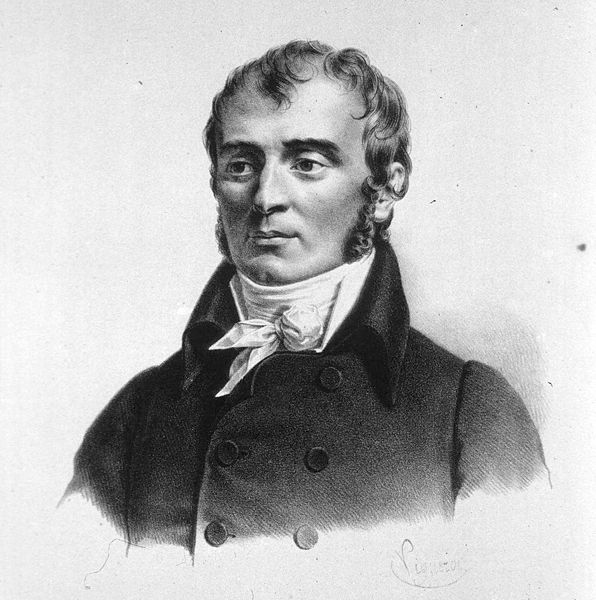<Back to Index>
- Anatomist Marie François Xavier Bichat, 1771
- Composer Fanny Cäcilie Mendelssohn, 1805
- King of England, Scotland and Ireland William III, 1650
PAGE SPONSOR

Marie François Xavier Bichat (November 14, 1771 – July 22, 1802), French anatomist and physiologist, was born at Thoirette (Jura).
Bichat is best remembered as the father of modern histology and pathology. Despite the fact that he worked without a microscope, he was able to advance greatly the understanding of the human body. He was the first to introduce the notion of tissue (tissues) as distinct entities. He maintained that diseases attacked tissues rather than whole organs. His father, a physician, was Bichat's first instructor. He entered the college of Nantua, and later studied at Lyon. He made rapid progress in mathematics and the physical sciences, but ultimately devoted himself to the study of anatomy and surgery under the guidance of M.A. Petit (1766 - 1811), chief surgeon to the Hotel Dieu at Lyon. The revolutionary disturbances compelled him to flee from Lyon and take refuge in Paris in 1793. There he became a pupil of P.J. Desault,
who was so impressed with his genius that he took him into his house
and treated him as his adopted son. For two years he took active part
in Desault's work, at the same time pursuing his own research in
anatomy and physiology. The
sudden death of Desault in 1795 was a severe blow to Bichat. His first
task was to discharge the obligations he owed his benefactor, by
contributing to the support of his widow and her son, and by completing the fourth volume of Desault's Journal de Chirurgie to which he added a biographical memoir of its author. His
next objective was to reunite and digest in one body the surgical
doctrines which Desault had published in various periodical works. Of
these he composed, Œuvres chirurgicales de Desault, ou tableau de sa doctrine, et de sa pratique dans le traitement des maladies externes (1798
- 1799),
a work in which, although he professes only to set forth the ideas of
another, he develops them with the clearness of one who is a master of
the subject. In 1797 be began a course of anatomical demonstrations,
and his success encouraged him to extend the plan of his lectures, and
boldly to announce a course of operative surgery. In the following year, 1798, he gave in addition a separate course of physiology. A dangerous attack of haemoptysis interrupted
his labors for a time; but the danger was no sooner past than he
plunged into new engagements with the same ardour as before. He had now
scope in his physiological lectures for a fuller exposition of his
original views on the animal economy, which excited much attention in
the medical schools at Paris. Sketches of these doctrines were given by him in three papers contained in the Memoirs of the Société Médicale d'Émulation, which he founded in 1796, and they were afterwards more fully developed in his Traité sur les membranes (1800). His next publication was the Recherches physiologiques sur la vie et la mort (1800), and it was quickly followed by his Anatomie générale (1801), the work which contains the fruits of his most profound and original researches. He began another work, under the title Anatomic descriptive (1801 - 1803),
in which the organs were arranged according to his peculiar
classification of their functions, but lived to publish only the first
two volumes.
Bichat died at the age of 31 from a fever following an unexplained fall down a set of stairs. He is buried at Père Lachaise Cemetery.
A large bronze statue of Bichat, work of the famous sculptor David D'Angers,
was erected in 1857 in the main courtyard (“Cour d’honneur”) of the
“René Descartes University” in 12, rue de l'Ecole de
Médecine, Paris, thanks to the support of the members of the
Medical Congress of France, which took place in 1845. On the pedestal
can be read the following inscription: A Xavier Bichat. Le Congrès Médical de France de 1845.